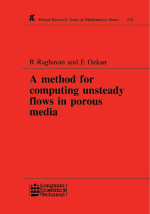Добрый день, Коллеги. Важное сообщение, просьба принять участие. Музей Ферсмана ищет помощь для реставрационных работ в помещении. Подробности по ссылке
A method for computing unsteady flows in porous media / Способ расчета нестационарных течений в пористых средах
Our primary interest is to consider three-dimensional flow in porous media, including fissured and layered media. We propose to provide for extraction or injection of fluids via points th at are complicated in geometry for a variety of conditions on the boundaries of the porous solid. Here, we preview our notation and address a few basic issues for ease of understanding.
Our notation is standard. The symbols x,y, and z denote the space variables in Cartesian coordinates and t denotes the time variable. $7 is a bounded domain in space and T is the boundary of ft. The position of a point in ft is defined by the position vector M = (x,y, 2). T denotes the time interval T ; { t |0 < t < oc}. The space-time domain D = ft x T is the product of the region ft and the time interval T. An inhomogeneous porous medium occupies ft and a fluid (liquid or gas) flows through the porous medium. The porosity, <^(M; £), of the medium (defined as the void volume, Vp, per bulk volume, V), and the density, /?(M; t), of the fluid are both scalar functions of M and £, for M and t E D. Sources or sinks in D may supply or extract fluid. In the following development, we use the term source to denote both the supply and the extraction of fluid with the understanding that the strength of a sink is negative. We also drop the distinguishing notation for vectors. <...>




